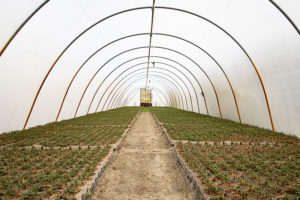You measure your eye level from one of your garden chairs as 115 cm and start looking for plants on the internet. There you come across an absolutely unbeatable offer: the plant you prefer, „Thuja occidentalis Smaragd” in the growth height 70-100 cm is offered to you at an absolute knockdown price. You think to yourself: “I’ll have dense plants in two years at the most, that’s fine. At this super price I won’t get bogged down by buying more expensive, larger plants”.You don’t hesitate for long and strike boldly.
A somewhat strange feeling comes over you when the plants are delivered: they seem a bit thin, a bit spindly and somehow short. But well, there’s no hesitating or faltering: you go out into the garden and plant cheerfully at the recommended planting distance.
Once this task has been completed, you decide to enjoy the reward of your efforts by taking a seat on your patio and enjoying a glorious view of your new garden …
WHAT'S THAT???
Horrified, you gaze at the thin little plants that sadly form a row of full of gaps with distinct viewing holes. And as if that isn’t enough: your gaze meets your neighbours’ seating area unhindered. It’s not just a few centimetres of plant height (and width) missing for the privacy screen. It’s at least half the required height, according to their estimation. And your re-measurement confirms: your hedge plants are not even 60 cm high. How can that be?
Let's leave this unpleasant scene.
Countless hedge buyers experience situations like this every year, only to ponder long and hard whether the misery they have planted should be replaced by suitable plants in a second, incomparably larger edition, or whether they should endure the sight of their own failure in a process lasting many years until the little plants they have planted actually develop into a hedge.
Where were the mistakes made?
-
Let’s take a look at what caused the disastrous result in this example:
- Depending on your distance from the hedge, you have to add at least 15 cm to your measured eye level, even at close range, in order to achieve a real privacy effect. In other words, the planned height of the hedge in the example should have been at least 130 cm.
- The plants purchased were advertised as the size “70-100 cm”. The seller in the example has cheated you in more ways than one – even if it is completely legal: respectable plant growers and dealers give their size information in the form of growth height. In other words, a plant with the size specification 100 cm is also 100 cm high, plus the pot with the (after planting) underground roots. Some internet retailers are now cunning enough to give the size specification as a total height specification. In our case, all the plants would suddenly be about 13 cm (pot height) shorter than you had imagined. Likewise, respectable plant growers and dealers usually make their size gradings in 20 cm ranges. 80-100 cm is a common selling size, 70-100 cm is not. It is also bad for you if you only get plants from the lower end of the scale, i.e. exactly or just over 70 cm.
- The supposed super bargain was also so cheap because the plants were delivered in a pot that was too small. The plants were “doped” for height for quick sellability and were therefore disproportionately thin and light. There was also a significant risk that these plants would have a high failure rate and take a long time to regenerate. As a result, the further growth rate of the plants would also be severely impaired.
So, what are the bottom line findings?
IIn our example, the exact opposite was behind a supposed bargain that would have produced a complete privacy screen in two years of growth: with a height of almost 60 cm and poor roots, our example hedge would have taken years to grow at the rate that is usual for “Thuja occidentalis Smaragd” of around 10 cm in height and 4 cm in width. Specifically, it would have taken our buyer about 8-9 years to produce the target privacy screen they were looking for.
What to look out for:
Avoid similar pitfalls: When specifying the size of plants, always pay meticulous attention to whether they are talking about growing heights or total heights with pots. Whenever you are tempted by supposed super bargains, there is always a catch. Go for pot-grown plants, pay attention to pot sizes and don’t fall for offers without a comprehensive growing guarantee. – Good producers and dealers vouch for the success of your hedge plants in your garden. Last but not least, don’t calculate plant growth after planting. Reputable dealers will give you serious growth figures that you should calculate with. Especially for issues of privacy, honestly answer the question of how long you want to wait for a dense privacy screen and invest in hedge plants of the necessary size.
Finally, we would like to recommend the Saterplant® online shop for guaranteed first-class plant quality from northern German production – for hedge plants that will last for decades and give pleasure.
PS: If you are interested in more comprehensive tips, please also read I want to plant, extend or replace a hedge: what should I know about buying hedge plants?







